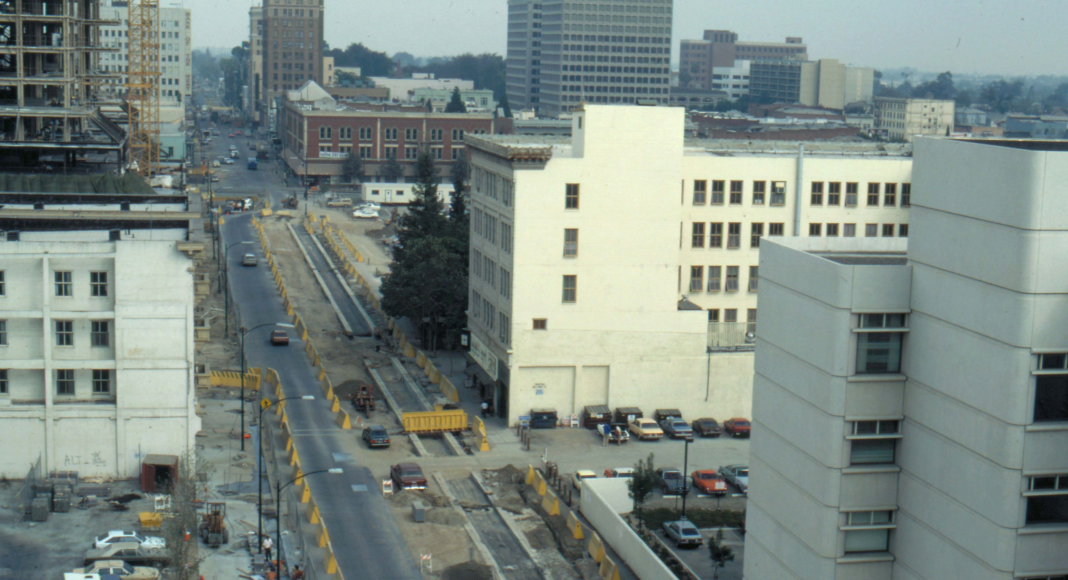The San Jose Redevelopment Agency did one thing right. They took pictures.
For example, consider a mid-’80s photo depicting wreckage caused by light rail construction and the imminent gutting of streets. It reminds me of pre-war footage, as if someone anticipated the bombardment of Iraq and then took photos for future generations. In the photo, hidden behind the trees, is construction of the failed $35 million Pavilion shopping mall, which triggered the next 30 years of everybody trying and failing to salvage the whole disaster.
Thanks to this photo, presumably taken from the historic Pestana building at First and San Carlos—now a parking lot—we can look north along First Street at one moment in time during a long apocalyptic phase when all of downtown was a panorama of ruin. For several years, the streets were torn to pieces and pedestrians had to walk on planks to access retail businesses. At the left, one sees the Montgomery Hotel, an abandoned relic from generations past, which had not yet been remodeled. Right behind it, the Fairmont construction is underway. Across the street is the Twohy building when it was still a crumbling office complex. The empty parcel north of the Twohy building, across the future Paseo de San Antonio, is where the Pavilion construction was just starting.
The Pavilion was a double-decker open-air mall situated diagonally between two entrances: one along the paseo and another that opened onto First St. The mall erupted with tremendous fanfare in May of 1989—almost a year late because the Redevelopment Agency could not find any anchor tenants. They refused Target because they wanted something fancy. When the Pavilion did finally open, more than 40 smaller tenants were on board, including Victoria’s Secret, Benetton and Laura Todd Cookies. A few years later, almost all of them were out of business.
The city thought force-cramming ritzy retail into a neighborhood where no ritzy people lived would trigger a million well-heeled suburbanites to come back downtown every year. It never happened. A colossal waste of public money, the Pavilion was an abject failure and a grand civic embarrassment. As the mall faded, Mercury News columnist Scott Herhold wrote that “customers in the Pavilion were about as frequent as fish jumping from the Guadalupe.”
Meanwhile, two blocks south, with no million-dollar subsidies, venues like the Cactus Club, the Ajax Lounge and F/X hosted up-and-coming acts like Nirvana, No Doubt, Weezer, Korn and Alanis Morissette, creating a vibrant scene that gave San Jose name recognition across the country. Every national touring rock band knew San Jose at that time. The politicians didn’t care about any of that, of course. They wanted Laura Todd’s cookies instead.
For me, the only interesting retailer inside the Pavilion was an outré shop called The Two Virgins, operated by Pauline Sortor, who sold imported foods, jewelry, coffee and other items, a locally owned indie-curated sanctuary, commendably staffed by goth babes from the rock scene down the street. Sortor became a freedom fighter against the Redevelopment Agency and the conniving landlords. When she finally relocated the shop in 1996, Sortor was one of the last remaining original Pavilion tenants. Mercury News columnist Larry Slonaker called her a “genuine San Jose hero,” adding that “they should put up a statue of her downtown, instead of Thomas Fallon or Quetzalcoatl.”
By the late ’90s, only a handful of newer tenants remained inside, including a 20,000-square-foot virtual reality center that never even opened. As a result, the next property owners put the Pavilion out of its misery once and for all, closing off the entrances and converting the whole structure into offices for a networking company. Several street-facing businesses along the perimeter then subsequently opened and failed for the next 20-plus years, straight up until the current day.
Now, the last round of those businesses is on the way out because another new landlord is set to (re)destroy the whole building all over again and then probably bamboozle the next generation of tenants for the next 20 years, until the structure is converted into something else yet again. This is how downtown San Jose has always worked. And this is just one particular building.
But at least we have pictures. Even if the block was never truly developed, at least the photos were.




I remember walking along the area in the photo as Frank Taylor and Tom McEnery pushed for the high rent retail in a low rent neighborhood, served a bit later by the 19th century trolley crawling along in the downtown core. And now we can look forward to the same destruction along East Santa Clara Street for several years during the big dig for BART, followed by hard-up pimps, hookers, and drug dealers riding south from Oaktown, Hayward, and Fremont to ply their trades.
I remember going to check out the Pavilion and the only product I remember before getting tired of it all were $500+ handbags. It didn’t seem like they were going to be big sellers.